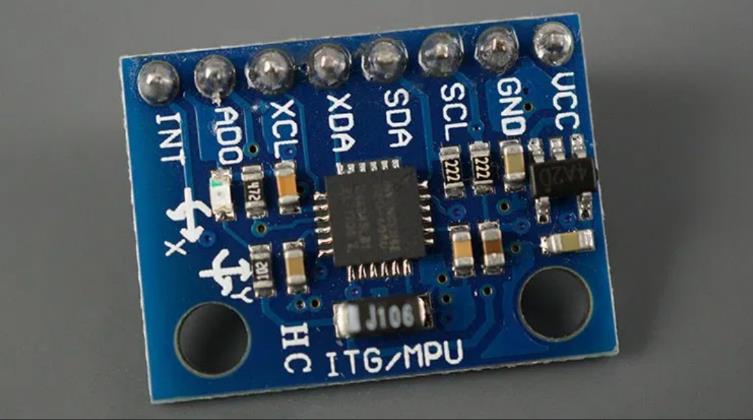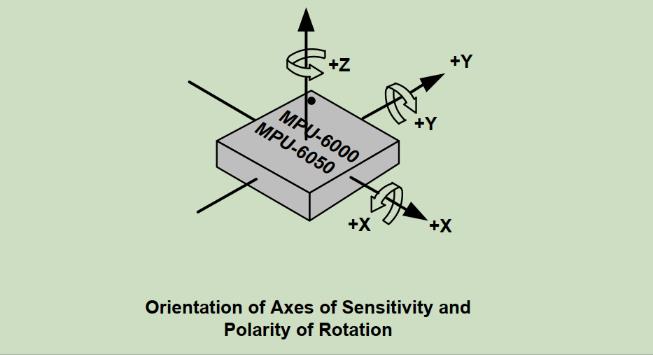ESP32上手笔记 | 05 - 获取MPU6050数据进行姿态解算和展示(I2Cdev+MPU6050+Processing)
Posted Mculover666
tags:
篇首语:本文由小常识网(cha138.com)小编为大家整理,主要介绍了ESP32上手笔记 | 05 - 获取MPU6050数据进行姿态解算和展示(I2Cdev+MPU6050+Processing)相关的知识,希望对你有一定的参考价值。
一、MPU6050陀螺仪加速度计传感器
1. 介绍
MPU6050是一个带有3轴加速度计和3轴陀螺仪的传感器,也称之为惯性测量单元(IMU)传感器:

陀螺仪测量回转的速度(rad/s),是在X、Y、Z三个轴的角位置变化,分别称为roll、pitch、yaw,这可以使我们判断物体的朝向:

加速度计用来测量加速度,也就是物体速度的变化率。
2. 模块引脚说明
- VCC:3.3V
- GND
- SCL:用于I2C通信
- SDA:用于I2C通信
- XDA:用来连接其它的I2C传感器到MPU6050
- XCL:用来连接其它的I2C传感器到MPU6050
- AD0:用来设置I2C从机地址
- INT:中断引脚,用来表示有新的测量数据可用
3. I2C通信协议
MPU6050的I2C从机地址是110100X,7bit长度,最低位X由AD0引脚来控制。
MPU6050支持的最大I2C速度为400kHz。
二、i2cdevlib
I2C Device Library(i2cdevlib)是一组基本统一且文档良好的类的集合,为I2C设备提供简单直观的接口。
1. 安装库
Github仓库地址:https://github.com/jrowberg/i2cdevlib
拉取到之后,将其中Arduino下的I2Cdev文件夹和MPU6050文件夹复制到platformIO工程的lib路径中。

2. 使用库
包含头文件:
#include "I2Cdev.h"
#include "MPU6050.h"
2.1. 创建MPU6050对象
MPU6050_Base(uint8_t address=MPU6050_DEFAULT_ADDRESS, void *wireObj=0);
构造函数中address参数是指MPU6050的从机地址,
默认是0x68(AD0引脚为低电平),如果AD0引脚接为高电平,可以指定地址为0x69。
2.2. 初始化
/** Power on and prepare for general usage.
* This will activate the device and take it out of sleep mode (which must be done
* after start-up). This function also sets both the accelerometer and the gyroscope
* to their most sensitive settings, namely +/- 2g and +/- 250 degrees/sec, and sets
* the clock source to use the X Gyro for reference, which is slightly better than
* the default internal clock source.
*/
void MPU6050_Base::initialize();
2.3. 测试通信是否正常
/** Verify the I2C connection.
* Make sure the device is connected and responds as expected.
* @return True if connection is valid, false otherwise
*/
bool MPU6050_Base::testConnection()
return getDeviceID() == 0x34;
2.4. 获取六轴数据
/** Get raw 6-axis motion sensor readings (accel/gyro).
* Retrieves all currently available motion sensor values.
* @param ax 16-bit signed integer container for accelerometer X-axis value
* @param ay 16-bit signed integer container for accelerometer Y-axis value
* @param az 16-bit signed integer container for accelerometer Z-axis value
* @param gx 16-bit signed integer container for gyroscope X-axis value
* @param gy 16-bit signed integer container for gyroscope Y-axis value
* @param gz 16-bit signed integer container for gyroscope Z-axis value
* @see getAcceleration()
* @see getRotation()
* @see MPU6050_RA_ACCEL_XOUT_H
*/
void MPU6050_Base::getMotion6(int16_t* ax, int16_t* ay, int16_t* az, int16_t* gx, int16_t* gy, int16_t* gz);
三、获取MPU6050原始数据
1. 硬件连接

2. 代码编写
#include <Arduino.h>
#include "I2Cdev.h"
#include "MPU6050.h"
#include "Wire.h"
class IMU
private:
MPU6050 imu;
int16_t ax, ay, az;
int16_t gx, gy, gz;
int16_t temperature;
public:
int init();
void update();
int16_t getAccelX();
int16_t getAccelY();
int16_t getAccelZ();
int16_t getGyroX();
int16_t getGyroY();
int16_t getGyroZ();
int16_t getTemperature();
;
IMU imu;
void setup()
Serial.begin(115200);
imu.init();
void loop()
imu.update();
// display tab-separated accel/gyro x/y/z values
Serial.print("a/g/t:\\t");
Serial.print(imu.getAccelX()); Serial.print("\\t");
Serial.print(imu.getAccelY()); Serial.print("\\t");
Serial.print(imu.getAccelZ()); Serial.print("\\t");
Serial.print(imu.getGyroX()); Serial.print("\\t");
Serial.print(imu.getGyroY()); Serial.print("\\t");
Serial.print(imu.getGyroZ()); Serial.print("\\t");
Serial.println(imu.getTemperature());
delay(100);
int IMU::init()
// initialize i2c
Wire.begin();
Wire.setClock(400000);
// initialize device
Serial.println("Initializing I2C devices...");
imu.initialize();
// verify connection
Serial.println("Testing device connections...");
if (imu.testConnection())
Serial.println("MPU6050 connection successful");
return 0;
else
Serial.println("MPU6050 connection failed");
return -1;
void IMU::update()
// read raw accel/gyro measurements from device
imu.getMotion6(&ax, &ay, &az, &gx, &gy, &gz);
// read temperature
temperature = imu.getTemperature();
int16_t IMU::getAccelX()
return ax;
int16_t IMU::getAccelY()
return ay;
int16_t IMU::getAccelZ()
return az;
int16_t IMU::getGyroX()
return gx;
int16_t IMU::getGyroY()
return gy;
int16_t IMU::getGyroZ()
return gz;
int16_t IMU::getTemperature()
return temperature;
3. 测试结果

四、获取MPU6050 DMP姿态解算数据
1. 姿态解算
2. 硬件连接
添加 引脚GPIO16用来连接MPU6050中断引脚:

3. 代码编写
#include <Arduino.h>
#include "I2Cdev.h"
#include "MPU6050_6Axis_MotionApps20.h"
#include "Wire.h"
#define INTERRUPT_PIN 16
class IMU
private:
MPU6050 imu;
float euler[3]; // [psi, theta, phi] Euler angle container
float ypr[3]; // [yaw, pitch, roll] yaw/pitch/roll container and gravity vector
int16_t temperature;
// MPU control/status vars
bool dmpReady = false; // set true if DMP init was successful
public:
int init(uint8_t pin);
void update();
float getYaw();
float getPitch();
float getRoll();
int16_t getTemperature();
;
IMU imu;
volatile bool mpuInterrupt = false; // indicates whether MPU interrupt pin has gone high
void dmpDataReady()
mpuInterrupt = true;
void setup()
Serial.begin(115200);
imu.init(INTERRUPT_PIN);
void loop()
imu.update();
Serial.print("ypr\\t");
Serial.print(imu.getYaw());
Serial.print("\\t");
Serial.print(imu.getPitch());
Serial.print("\\t");
Serial.println(imu.getRoll());
delay(100);
int IMU::init(uint8_t pin)
uint8_t mpuIntStatus; // holds actual interrupt status byte from MPU
uint8_t devStatus; // return status after each device operation (0 = success, !0 = error)
uint16_t packetSize; // expected DMP packet size (default is 42 bytes)
// initialize i2c
Wire.begin();
Wire.setClock(400000);
// initialize device
Serial.println("Initializing I2C devices...");
imu.initialize();
// verify connection
Serial.println("Testing device connections...");
if (imu.testConnection())
Serial.println("MPU6050 connection successful");
else
Serial.println("MPU6050 connection failed");
return -1;
pinMode(pin, INPUT);
// load and configure the DMP
devStatus = imu.dmpInitialize();
// supply your own gyro offsets here, scaled for min sensitivity
imu.setXGyroOffset(220);
imu.setYGyroOffset(76);
imu.setZGyroOffset(-85);
imu.setZAccelOffset(1788); // 1688 factory default for my test chip
// make sure it worked (returns 0 if so)
if (devStatus == 0)
// Calibration Time: generate offsets and calibrate our MPU6050
imu.CalibrateAccel(6);
imu.CalibrateGyro(6);
imu.PrintActiveOffsets();
// turn on the DMP, now that it's ready
Serial.println(F("Enabling DMP..."));
imu.setDMPEnabled(true);
// enable Arduino interrupt detection
Serial.print(F("Enabling interrupt detection (Arduino external interrupt "));
Serial.print(digitalPinToInterrupt(INTERRUPT_PIN));
Serial.println(F(")..."));
attachInterrupt(digitalPinToInterrupt(INTERRUPT_PIN), dmpDataReady, RISING);
mpuIntStatus = imu.getIntStatus();
// set our DMP Ready flag so the main loop() function knows it's okay to use it
Serial.println(F("DMP ready! Waiting for first interrupt..."));
dmpReady = true;
// get expected DMP packet size for later comparison
packetSize = imu.dmpGetFIFOPacketSize();
else
// ERROR!
// 1 = initial memory load failed
// 2 = DMP configuration updates failed
// (if it's going to break, usually the code will be 1)
Serial.print(F("DMP Initialization failed (code "));
Serial.print(devStatus);
Serial.println(F(")"));
void IMU::update()
// orientation/motion vars
Quaternion q; // [w, x, y, z] quaternion container
VectorInt16 aa; // [x, y, z] accel sensor measurements
VectorInt16 aaReal; // [x, y, z] gravity-free accel sensor measurements
VectorInt16 aaWorld; // [x, y, z] world-frame accel sensor measurements
VectorFloat gravity; // [x, y, z] gravity vector
// MPU control/status vars
uint8_t fifoBuffer[64]; // FIFO storage buffer
// if programming failed, don't try to do anything
if (!dmpReady) return;
// read a packet from FIFO
if (imu.dmpGetCurrentFIFOPacket(fifoBuffer)) // Get the Latest packet
// display Euler angles in degrees
imu.dmpGetQuaternion(&q, fifoBuffer);
imu.dmpGetGravity(&gravity, &q);
imu.dmpGetYawPitchRoll(ypr, &q, &gravity);
// read temperature
temperature = imu.getTemperature();
float IMU::getYaw()
return ypr[0] * 180/M_PI;
float IMU::getPitch()
return ypr[1] * 180/M_PI;
float IMU::getRoll()
return ypr[2] * 180/M_PI;
int16_t IMU::getTemperature()
return temperature;
4. 测试结果

五、使用Processing进行姿态可视化
1. 安装Processing
下载地址:https://processing.org/download。
2. 安装toxiclibs库

3. 修改数据打印格式
添加格式定义:
// packet structure for InvenSense teapot demo
uint8_t teapotPacket[14] = '$', 0x02, 0,0, 0,0, 0,0, 0,0, 0x00, 0x00, '\\r', '\\n' ;
删除之前的打印格式:
Serial.print("ypr\\t");
Serial.print(imu.getYaw());
Serial.print("\\t");
Serial.print(imu.getPitch());
Serial.print("\\t");
Serial.println(imu.getRoll());
新增一个IMU类的发送数据函数:
void IMU::sendDataToProcessing()
// display quaternion values in InvenSense Teapot demo format:
teapotPacket[2] = fifoBuffer[0];
teapotPacket[3] = fifoBuffer[1];
teapotPacket[4] = fifoBuffer[4];
teapotPacket[5] = fifoBuffer[5];
teapotPacket[6] = fifoBuffer[8];
teapotPacket[7] = fifoBuffer[9];
teapotPacket[8] = fifoBuffer[12];
teapotPacket[9] = fifoBuffer[13];
Serial.write(teapotPacket, 14);
teapotPacket[11]++; // packetCount, loops at 0xFF on purpose
在update函数调用之后,调用该函数发送数据到上位机。
修改完毕,烧录代码。
4. 运行processing上位机
上位机为lib\\MPU6050\\examples\\MPU6050_DMP6\\Processing\\MPUTeapot\\MPUTeapot.pde,使用processing打开。
修改连接ESP32的串口:


以上是关于ESP32上手笔记 | 05 - 获取MPU6050数据进行姿态解算和展示(I2Cdev+MPU6050+Processing)的主要内容,如果未能解决你的问题,请参考以下文章